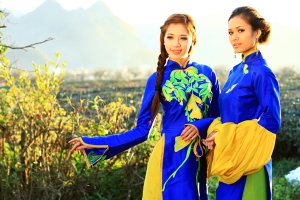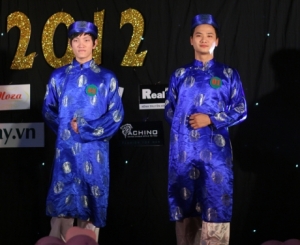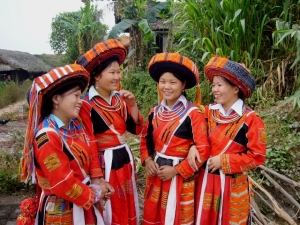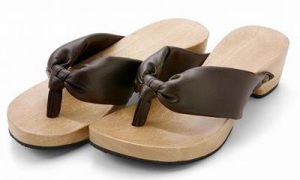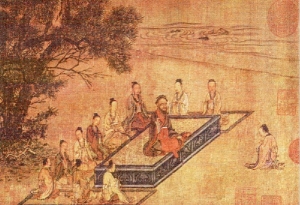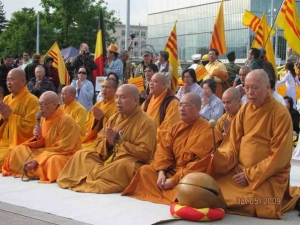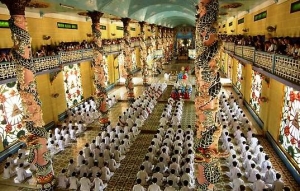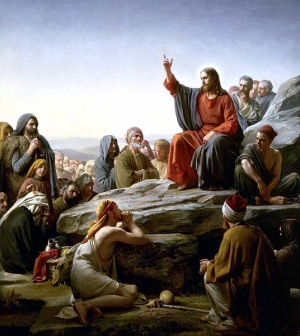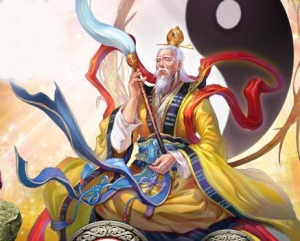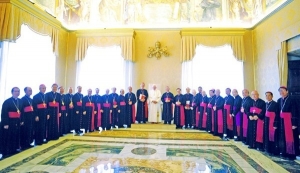
Asia Pacific Travel Team
Ao Dai Vietnam and its history
Foreign visitors joining Vietnam Tourism are deeply impressed by the traditional dress for Vietnamese women. It is called “Ao Dai."
Girl students dressed in white long robes take to streets on the way to schools or back home, or gracefully sail on their bikes along streets. Female secretaries in delicate pastels greet you at an office door and older ladies in deep shades of purple, green or blue cut a striking pose at a restaurant dinner. The ao dai appears to flatter every figure.
Its body-hugging top flows over wide trousers that brush the floor. Splits in the gown extend well above waist height and make it comfortable and easy to move in. Although virtually the whole body is swathed in soft flowing fabric, these splits give the odd glimpse of a bare midriff, making the outfit very sensual.
Ao dai is made individually to fit each customer's shape to create the most graceful possible look. The pants should reach the soles of the feet and flow along the floor.
Comfortability is always taken into account for fashions and beauty. Tailoring must ensure the wearer's freedom of movements. Despite it is a long robe, ao dai must be cool to wear. Synthetic or silk fabrics are preferred as they do not crush and are quick drying, making the ao dai a practical uniform for daily wear.
The color is indicative of the wearer's age and status. Young girls wear pure white, fully-lined outfits symbolizing their purity. Older but unmarried girls move into soft pastel shades. Only married women wear ao dai in strong, rich colors, usually over white or black pants. However, ao dai is rarely seen in places where manual work is practiced. The nineties saw a real resurgence of ao dai. It has become standard and common attire for girl students as well as female staff at offices and hotels. Traditionally, ao dai has become the most preferred dress on formal occasions.

Early versions of the ao dai date back to 1744 when Lord Vu Vuong of the Nguyen Dynasty decreed both men and women should wear an ensemble of trousers and a gown that buttoned down the front. However, not until 1930 did ao dai appear partly similar to its look today. Vietnamese fashion designer-cum-tailor Cat Tuong, called as Monsieur Le Mur by the French at that time, lengthened the top so it reached the floor, fitted the bodice to the curves of the body, and moved the button line from the front to the left side of the body. Men wore it less, generally only on ceremonial occasions such as weddings or funerals. But it took another 20 years before the next major design change was incorporated and the modern ao dai emerged. During the 1950s two tailors in Saigon, Tran Kim of Thiet Lap shop and Dung of a tailoring shop of the same name, started producing ao dai with raglan sleeves. This creates a diagonal seam running from the collar to the underarm and this style is still preferred today.
Nowadays, Ao dai has many variations compared with Ao dai in the past. However, it always keeps it traditional features that flatter the decency, discreteness and harmony for those who wear it. Therefore, it is not easy at all to think of a more elegant, demure, and yet sexy attire that suits Vietnamese women of all ages than the national costume - Ao dai.
Traditional Vietnamese dress for men
The special features of the national Vietnamese dress for men have been preserved through the ages. Vietnamese man is proud of wearing this dress because it is part of Vietnamese nation, their history and their culture in general. Moreover, it is part of Vietnamese social customs which includes respect for superiors, dignitaries and relatives. In the past, the people who wore different traditional dresses also showed their status in Vietnamese society.
Pa Then women's costume
Visitors to the northern provinces of Ha Giang and Tuyen Quang will enjoy the colourful costumes of women from the Pa Then ethnic minoirity.
Like many other ethnic groups in Vietnam, Pa Then people grow flax to weave the brocades and fabrics for making their traditional garments. Most of the adult Pa Then women learned how to weave and sew from their mothers. According to Pa Then custom, women have to learn these skills not only to make beautiful clothes, but also to prepare for their weddings.
A typical Pa Then woman's costume consists of a hat, a blouse, a belt, a skirt, and a brassiere. The broad flat hat is made of red cloth embroidered with various patterns and wrapped around the head in layers. The two sides are decorated with colourful tassels that cascade down to the wearer’s waist.
The most attractive part of the costume is the traditional red collarless blouse with that crosses over in the front and often longer in the back than the front. The costume is an attractive combination of hand-embroidery and appliqued fabric blocks. Geometrical patterns are embroidered on the red background while the under sleeves and appliques on the front of the blouse are black. Young women often wear a white shirt under the red blouse with the white collar on top of the red, giving it a rather striking appearance.
The skilled Pa Then women weave and create unique skirts. These skirts are also red and are pleated onto the waistband with embroidered decorations on the two side panels. The centre panel of the skirt is only decorated with simple designs.
The belt is a long white or black piece of cloth tied around the waist, with the two tails ends dangling down the front.It takes Pa Then women nearly one month to make a complete traditional costume. Making the decorative elements and and doing the embroidery takes the most time. However, their traditional costume is always in the same model, and they wear it year round during their daily activities and at festivals. Visitors to the upland provinces of Ha Giang and Tuyen Quang will easily recognize Pa Then women because of their impressive and unique costumes.
Pa Then women look particularly charming at spring festivals in their traditional red costumes adorned with sparkling silver necklaces, ear-rings and bracelets.
History of Vietnamese clogs
Wooden clogs are the simple symbol of Vietnamese women.
T wo parallel and loving boats
With dragon bows and phoenix sterns
Double rows of nails
I carry five boy-lovers per boat
And ten per pair.
But, let you be reproved, you ingrate!
Profiting from me, and forgetting me
What am I?
The above riddle refers to a pair of clogs, footwear imbued with symbolic meaning in Vietnam. One popular legend tells of a pair of stone clogs passed down for generations by a family in Cao Bang, high in Vietnam's northern mountains.
Cao Bang was situated in what was then known as the Vu Dinh region of Van Lang - as the nation was then called. Vu Dinh was divided into nine zones, each of which was governed by a Po, or landlord. Highly competitive, the nine Po organized a contest to determine who was the most skillful.
One Po displayed his skill at planting rice seedlings, another his prowess at building boats, another his ability to grind a ploughshare into a needle in just one day. One was proud of his poetry, another of his skill at building citadels. The last Po showed off his proficiency at carving stone clogs. This Po managed to make a massive pair of stone clogs, which later generations used to span a stream in Ban Thanh village. This unusual bridge still exists today.
Given Vietnam's hot and humid climate and their days spent wading in wet rice paddies or fishing, Vietnamese people usually went barefoot.
At the end of the 10th century, King Le Dai Hanh often wore nothing but a loin-cloth, his feet bare. A Chinese Tong dynasty official, having been snubbed by King Le Dai Hanh, made a disdainful report about the rustic ways of the Vietnamese court. In fact, up until the Tran Dynasty (1225-1400AD), most Vietnamese people went barefoot.Even in those early times, however, clogs were not unknown. Ancient Chinese books like Nam Viet Chi and Giao Chau Ky record that in the third century, the leader of a Vietnamese resistance movement, Ba Trieu, wore a pair of ivory clogs. "Lady Trieu Au with breasts three meters long never married," reports a surprising passage in Giao Chau Ky. "Walking on stilts, she used to wear a type of clogs called Kim De Kich."
Formerly, on cold days, men and women from rural areas would don clogs made from bamboo roots when attending festivals or visiting friends. At home they wrote wooden clogs with vertical straps to protect the toes.
In Phu Yen in south-central Vietnam, people generally made their own clogs. They favored thick soles with slightly turned-up tips. The traps, which attached through a hole in the front and a pair of holes on the sides, were braided from soft cloth. Because the sole was curved at the front, the knot of the front strap did not rub on the ground.
The soles of women's clogs were shaped like hour-glasses, while men's clogs -known as "sampan clogs"- had straight soles. Made of white wood, Phu Yen clogs were left unpainted, while those from the central city of Hue were often painted in black and brown with a pale colored triangle on the side of the sole. Only well-to-do men wore painted clogs. Some areas called clogs don, hence the saying "a foot with a shoe, a foot with a don" to indicate rich people who put on airs.
Up until the 1940s, young pupils at public schools in the southern province of Ben Tre wore clogs. Before the August Revolution in 1945, clogs produced in Hue were called "capital clogs" or guoc kinh. These clogs had soles made from coconut shells or light wood, painted white and gold with embroidered straps. An advertisement from a Hanoi newspaper in the 1940s reads:
"Like finding a needle at the bottom of the sea, now, Flying Horse clogs have been discovered!"

In the 1950s and 1960s, wooden clogs produced in Dong Do village in the Thanh Tri district of Hanoi and Ke Giay in Ha Tay province were taken to 12 Hang Ga street or Bach Mai street in Hanoi to be painted and sold. As the following poem reveals,clogs were considered extremely romantic by young girls of the time:
Clogs long unheard
On the tree-lined streets
And spring comes, apples fall,
I remember your zither sounds.
(To Huu)
By the 1970s, plastic clogs rivaled wooden clogs in popularity. Considered stylish and comfortable, clogs could offer other, more unusual, benefits. Travelers would sometimes bore holes in the wooden soles to hide gold or jewels.
While countless Vietnamese poets have waxed lyrical about the conical hat and traditional ao dai tunic, clogs have been all but ignored by the nation's bards. One exception is the following Ca Dao poem:
"A walk in clogs round the garden in the morning,
Herons are singing and crying
Half for fate, half for their destiny.
(Ca dao poem from south-central Vietnam)
On the other hand, clogs are often the subject of riddles:Two females in colored dresses. Each carrying five males on their backs On the way, talk and chat, And left alone at home: fed up! What is this?
From Ba Trieu's ivory clogs to clogs made of bamboo, wood and plastic, this humble footwear has covered a lot of ground on Vietnam.
Confucianism
Confucianism can be considered as a social philosophy than just a normal religion. It has no church, no clergy and no bible as well. It advocates a code of social behavior that man ought to live in harmony with society and attain happiness in his individual life.
Confucianism was introduced into Vietnam early during the Chinese rule and has maintained its influence since that time. In 1072, there was a temple dedicated to Confucius and his leading 72 disciples. Located in Hanoi, this temple was called the Temple of Literature. If one of you has ever been Saigon, you can see at the Botanical Gardens a temple dedicated to Confucius called the Temple of Souvenirs. This is the site of Confucius' birthday celebration which is solemnly honored each year.
What is Confucianism?
As a major emphasis in its ethical system, Confucianism regulates relations between people. If there is improper conduct of these relations, it will cause disorders in the social group and therefore, throw man out of harmony with the universe. The cosmic world (heaven and earth) are in harmony and man's aim is to achieve a similar one. Vietnamese Confucianism, though without a strong formalized organization, still vitally affects nearly all ethnic Vietnamese. This is part of the cultural environment where the child is born.

Khong Tse - the founder of Confucianism
The influence of Confucianism in Vietnam
The profound impact of Confucianism remains strong in Vietnam. Social order is defined by its principle as well as the rituals, deference and obedience.
Confucianism gave Vietnam a highly organized hierarchical society. Yet, while encouraging the improvement of the individual, it did also appeal his positive relationship with the community. In this sense, Confucianism is anti-individualistic.
According to Confucianism, death does not mean the annihilation of man. Confucianists believe that, the spirit which wanders in space as an exile should be brought back to the family altar and be worshiped. Besides, filial reverence is the primary duty of all Confucianists. That the reason why, on all solemn occasions, the ancestral spirit is invoked and offered liquors, flowers and fruit, accompanied with prayers and incense.
Confucianism is vividly seen throughout Vietnam in the Festival of the Arrival of Spring, the Mid-Autumn Festival, the Children's Festival and the Festival of Tet.
Tet is the festival of renewal and rebirth, or meditation and hope. With fireworks, ringing bells, beating tom-toms, toys and food, Tet is a big occasion in Vietnam. Many folk visit the pagodas to worship, burn joss-sticks and sandalwood incense, with flowers, food and liquors placed also on the family altars.

The other worship occasions involve the worship of the land. Such ceremonies include the festival of the beginning of plowing, the rice festival, the harvest festival and the festival of the first fruits. In spite of drought, war, foods… the Vietnamese farmer never seems to lose faith in the land as he plows, plants, harrows, weeds and irrigates it. To express his thankfulness for such response, the land is given honor in seasonal festivals which expressing their hopes and efforts of the past and for the future. Such worship of the land has tended to create in the Vietnamese peasant an almost fanatical attachment to his birthplace which nourished him during his life. It is the combination of worship of the land and ancestor veneration that creates the sight of numberless graves being scattered throughout the farming areas of Vietnam.
Besides, Confucianism has exercised a powerful influence in the formation of Vietnamese society where family is the basic unity. Thus, the three fundamental principles which govern Vietnamese women are the obedience to father until married, the obedience to husband while married, the obedience to eldest son when husband is dead
However, the value of Confucianism as a moderating influence upon social behavior is being rapidly superseded by the flexibility and openness in a developing society.
Buddhism
In theory there are three main religions in Vietnam: Taoism, Confucianism and Buddhism; but in fact there is “tripple religion”, which is an amalgamation of these three doctrines, each of which represents a particular aspect of the whole. And now Buddhism still is main religion in Vietnam.

Buddhism spread first from China to Vietnam's Red River Delta region in approximately the second century A.D., and then from India to the southern Mekong Delta area at some time between the third and the sixth centuries. The Chinese version, Mahayana Buddhism, became the faith of most Vietnamese, whereas the Indian version, Theravada (or Hinayana) Buddhism, was confined mostly to the southern delta region. The doctrinal distinction between the two consists of their differing views of Gautama Buddha: the Mahayana school teaches that Gautama was only one of many "enlightened ones" manifesting the fundamental divine power of the universe; the Theravada school teaches that Gautama was the one-and-only enlightened one and the great teacher, but that he was not divine. The Mahayana sect holds further that laypersons can attain nirvana, whereas the Theravada school believes that only ordained monks and nuns can do so.
At the 13 century, during the Tran dynasty (1225-1400), the first 3 Kings Trần Thái Tôn, Trần Thánh Tông, Trần Nhân Tông and many high-ranking mandarins and royal members were Zen Buddhists. Among them King Trần Nhân Tông was the most prominent, being the founder of Trúc Lâm Yên Tử Zen School after his retirement from the throne in 1299. The essence of Truc Lam Yen Tu Zen school is to “live the dharma” and Trần Nhân Tông’s life is the illustrated example. Trần Nhân Tông’s Truc Lam Yen Tu Zen School marked the beginning and foundation of Vietnamese Buddhism, which is exemplified by the tenet, “Dharma applied to worldly life,” all of the characteristics of which are outlined in the verse Cư Trần Lạc Đạo. In this interpretation of Buddhism, practicing Buddhism is not limited to ritual activities, worship, and meditation, but right within daily activities. There is no need to search for enlightenment and peace anywhere outside of self and of the environment one lives in.
Vietnamese Buddhism continues to hold this supremacy in our own time. It is therefore easy to understand how great an influence the Buddha has had on the Vietnamese mind, and the generous contribution it has made to the moral and spiritual training of a people whose gentleness and simple outlook on life predisposed them to accept the «Religion of Compassion.»
The "Vatican" of Caodaism
Welcome to the world of Caodaism - an extraordinary indigenous religion that has captured the belief of over two million Vietnamese and the whimsy of everyone. Compared with other religions that have existed for millennia, this little-known religion is a visual and theological spectacular that could have been created only in the 20th century.
Overview
Dao Cao Dai (Caodaism in English) is the third largest religion in Viet Nam after Buddhism and Roman Catholicism. "Cao" means "high"; "Dai" means "palace". The word refers to the supreme palace where God reigns and also used as God's symbolic name. It originated in South Viet Nam in the early twenties and was officially inaugurated in 1926.
Caodaism is a religion which combines elements from many of the world's main religions, including Buddhism, Confucianism, Christianity, Hinduism, Islam, Judaism, Taoism, as well as Geniism. It is syncretistic in its doctrine, ritual practice, organizational structure, divinities and philosophy.

History behind.
The history of this religion underwent three important episodes of revelations. The first and second took place in 6th century before our era. During the first manifestation, God appeared under the three forms of Jewish leader in the Middle East, Buddha in India and Fou-Hi symbolizing the cult of humanity in China.
During the second manifestation, Buddhism reappeared in the form of Sakiamuni, Confucianism in that of Confucius, Christianity in that of Jesus-Christ, Taoism in that of Lao-Tseu and Islam in that of Mohamed.
As for the third manifestation, God has decided to reveal himself. This third manifestation based on Buddhism is often called "Ðại Ðạo Tam Kỳ Phổ Ðộ" (Great Way for the Third Universal Amnesty).)
Ngo Van Chieu, a civil servant of the Cochin china government began to receive messages from a spirit called Duc Cao Dai whom he believed to be God. After three years of studying and worshipping God, he shared his spiritual discoveries with others in Saigon. According to him, the alliance represented in Caodaism is God's third attempt to reveal his truth to humanity
At the end of the year At Suu (1926 CE), Cao Dai instructed a small group of mediums to found a new religion. One of the mediums, Le Van Trung was named by God to be acting Giao Tong (Pope).
With the unification of Viet Nam in 1975, the Caodaists' activities were restricted by the Communist government. Their Cuu Trung Dai (executive body) and Hiep Thien Dai (legislative body) were abolished and replaced with a Governing Council under the direct control of the government. Rituals and ceremonies continued without government interference.
Caodaist ethics are based on the Buddhist ideal of becoming a good person with a veneer of traditional Vietnamese taboos. Basic parameters such as avoiding killing, lying, opulent living, sensuality, stealing and eating meat that facilitate the soul's progress through the cycles of reincarnation.
The Caodaist consider vegetarianism is one of humane service as it doesn't involve harming other creatures during the process of their spiritual evolution. They follow several different vegetarian regimens; the least rigorous one is to eat vegetarian meals six days a month. However, priests are required to be full-time vegetarians.
Intensifying its distinct if somewhat contradictory nature, Caodaism simultaneously embraces monotheism and ancestor worship, proselytizing and praying for acceptance. And although they believe in only one God, Caodaists also recognize another principal deity--the Mother Goddess. A popular debate among the Caodaists focuses on which deity was the primary source of creation. The acknowledgment of both genders pervades the religion. The celibate clergy consists of both men and women. In a hierarchical structure similar to the Roman Catholic Church, female priests occupy all but the highest levels. However, when male and female clergy of the same rank work together, the men function as leaders.

With brightly robed priests and colorfully painted temples, Caodaist ceremonies are visually spectacular. They occur four times each day: 6 am, noon, 6 pm and midnight. Women enter the temple from the left, walk clockwise around the hall, and then congregate on the left side for worship. Conversely, men enter from the right and walk counter-clockwise. Both genders give offerings that range from the conventional incense, fruit and flowers to more unusual gifts of tea and alcohol.
The "Vatican" of Caodaism resides in Tay Ninh- a province 58 miles northwest of Saigon at an ornate cathedral called The Holy See. Built between 1933 and 1955, The Holy See has been described as a rococo extravaganza and the Disneyland of religious centers. The main religious centers currently have 7 to 8 million followers in Vietnam and about 30,000 members elsewhere, primarily in Asia, Australia, Canada, Europe and the United States.
The architectural combination of a church, pagoda and shopping center creates an idiosyncratic place of worship. Looking at the garish central hall, you will see that it has nine levels that represent the nine steps to heaven. The impressive colonnade consists of bright pink columns encircled by thick enameled dragons with stylized scales. The dome is filled with a low hanging blue globe decorated with the "divine eye" gazing down at the worshipers. Merely entering the building is a powerful experience. Do you know that this eye is the official symbol of the church, representative of the visions that created this religion?
With its historical and ceremonial pageantry, Caodaism is a fascinating addition to Vietnamese religious sects. In its effort to create an ideal religion by fusing secular and sacred philosophies of both East and West, Caodaism has succeeded in being unarguably unique.
Christianity
Christianity was introduced to Vietnam in the 16th century by missionaries from Europe’s main Catholic evangelist countries, France, Spain and Portugal. One of the early arrivals was Alexandre de Rhodes, a French Jesuit who greatly impressed the Trinh lords who ruled the north at that time, thus easing the way for permanent missions in Hanoi, Danang and Hoi An.
Christianity enters Vietnam
Christianity was introduced to Vietnam in the 16th century by missionaries from Europe’s main Catholic evangelist countries, France, Spain and Portugal. One of the early arrivals was Alexandre de Rhodes, a French Jesuit who greatly impressed the Trinh lords who ruled the north at that time, thus easing the way for permanent missions in Hanoi, Danang and Hoi An.
Expulsion from Vietnam
As the creator of the Romanised written form of the Vietnamese language, Alexandre de Rhodes could justifiably be considered as one of the founding fathers of modern Vietnam. However, his reward was expulsion along with all the other Christians when the Trinh lords decided that Christianity in the form of Catholicism was subverting the beliefs that kept them in power. Apart from its later use in the Catholic Church in Vietnam, his script was ignored until the 20th century.
However, de Rhodes continued to proselytise through the Societe des Mission Etrangeres, a French evangelical organisation he helped to create, seeking converts throughout Indochina. In the following years, Catholicism was re-established in Vietnam and grew rapidly.
Oppression under Minh Mang
By the beginning of the 19th century, there were many thousands of Catholics in Vietnam. Catholicism’s relationship with Vietnam’s rulers was uneasy: the kings were wary of its doctrine of equality in the eyes of God, a belief that directly challenged the feudal Confucian system that legitimated their control. Under King Ming Manh, a strict Confucian, suspicion turned to oppression. Churches were razed, and Vietnamese and foreign devotees refusing to renounce their faith were executed.
Enter the French
Minh Mang’s excesses, although much exaggerated, gave the French the excuse they were looking for to invade, and Catholicism was reinstated. The Catholic Church flourished under the colonialists’ patronage, opening missions, schools and hospitals all over the country, and becoming Vietnam’s largest landowner. Vietnamese Catholics were favoured above their compatriots and became an educated elite.
An exodus to the south
By the 1950s, with the communists governing in the north, over half a million Catholics crossed the demilitarised zone to settle in the south, then controlled by the Saigon regime led by President Ngo Dinh Diem, a Catholic. Those that remained in the north were allowed to continue to practice their faith, but under tight control.
The post-war years
After reunification, the communists placed restrictions on the Catholic Church and imprisoned several of its leaders who had actively opposed the new government. Since then, controls have relaxed and relationships between Vietnam and the Vatican have become cordial. However, a papal visit to the second-largest Catholic population in Southeast Asia is still some way off.
The Protestant faith
Protestantism was mainly introduced by the Americans in the south in the form of militant evangelism, and now claims approximately half a million adherents. Many of these are in the ethnic groups of the Central Highlands. In recent years, there has been considerable unrest in the area. American ‘Gospel’ organisations frequently issue ‘reports’ alleging human rights abuse and denial of religious freedom. Putting aside the issue of differing perceptions between the US and Asia about what constitutes ‘human rights’, a trawl of the Internet soon reveals that the aim of many such groups are more political than religious.
The buildings
From a visitor’s point of view, many Catholic churches are well worth a visit. The Gothic edifices of Ho Chi Minh City, Hanoi, Hue and Da Lat are replicas of European cathedrals, and often built of imported materials. They have attractive features, but the home-grown products are of greater interest to the traveller.
The famous ‘Stone Church’
In particular, the ‘Stone Church’ of Phat Diem in the north, the bell tower of which was immortalised by Graham Greene in ‘The Quiet American’, is a highly satisfying blend of Christianity and the orient. The lifetime achievement of a Vietnamese cleric, Father Tran Luc, it is an architectural gem combining what looks like a Vietnamese temple at first sight with Christian symbolism and statuary. The interior is stunning – a 75m roof supported by huge ironwood pillars and a magnificent altarpiece.
Unusual churches
Many of the churches in the Central Highlands also combine Western and Eastern styles and some have highly unusual features, reflecting the area’s strong animist tradition
Taoism – a part of the Tam Giao (Three Religions) of Vietnam
Tam Giao, which includes Buddhism, Confucianism and Taoism, plays the key role in Vietnamese religion. “Tao” means “path” or “way” that turns Taoists’ thoughts to health, longevity, immortality and spontaneity.
The origin of Taoism
Taoism is believed to be founded by Lao Tseu (Lao Tu), a Chinese contemporary of Confucius in about 500 B.C. The ideas and doctrines of his religion are explained in his book entitled Dao Duc Kinh (The Book of Morality).
He did spend his life on searching for a way that would avoid the constant feudal warfare and conflicts that disrupted society during his lifetime. Taoism, therefore, is the natural mode of behavior that encourages one to live purely and simply. It relies on harmony between Man, Nature and a Universal Order. Such a harmony would promote good will, personal integrity. The ritual of Taoism in Vietnam today consists of religion-magical features, divining, worship of the spirits of nature, and so forth

Yin-Yang symbol
The Yin Yang is a common theme in Taoism, with black representing yin and white representing yang. The symbol was derived from astronomical observations which recorded the shadow of the sun throughout a full year. The two swirling shapes inside the symbol give the impression of change - the only constant factor in the universe. Hence, another idea states that, Yin - the dark side- represents the breath that formed the earth or symbolizes for the feminine which is soft, cool, calm, introspective, and healing… In contrast, Yang - the bright side- symbolizes the breath that formed the heavens and associate with the masculine: hard, hot, energetic, moving, and sometimes aggressive. However, since nothing in nature is purely black or purely white, the symbol includes a small black spot in the white swirl, and a corresponding white spot in the black swirl.
The implications of Yin and Yang
The Yin Yang symbol reflects the inescapably intertwined duality of all things in nature. No quality is independent of its opposite, nor pure. This principle applies to all elements of existence – from nature to a particular individual. Social disturbance, natural disasters, personal illness, unsettled family relationships and so on are the results of an imbalance between the forces of Yin and Yang
A comparison between Taoism and other beliefs
The congruity of Taoism and Confucianism is obvious. Confucianism is a means of regulating behavior without a spiritual dimension while Taoism grant people precepts that mostly go without spirituality and mysticism. Like some aspects of Buddhism, Taoism seems to have overtones of pessimism and a negative attitude toward attempts to change drastically the life patterns.
Roman Catholicism in Vietnam
Despite the Roman Catholic Church's rejection of ancestor worship, a cornerstone of the Confucian cultural tradition, Roman Catholicism established a solid position in Vietnamese society under French administration.
To the French, Roman Catholicism brought about a balance between Buddhism and the Western culture. After the mid-1950s, Catholicism declined in the North, where the communists regarded it as a reactionary force opposed to national liberation and social progress. In the South, by contrast, Catholicism expanded during the Ngo Dinh Diem regime, which the Catholics filled key positions in the government, the army, and the police against North Vietnam.

Pray for the Catholics in Vietnam
By November 1977, the Government of Vietnam allowed religious freedom for the Catholics with the condition that all Catholic organizations will be under the control of the communist government. To bring forth the support of the Vietnamese Catholics the communist government established the Unified Bishops’ Council of Vietnam and the Committee for Solidarity of Patriotic Catholics.
Today there are about three million Christians in Vietnam, most of them Catholics. Although they represented a small percentage of the population, the Catholics played an important role in the political life of Vietnam during the last three decades prior to the fall of Saigon in 1975.


